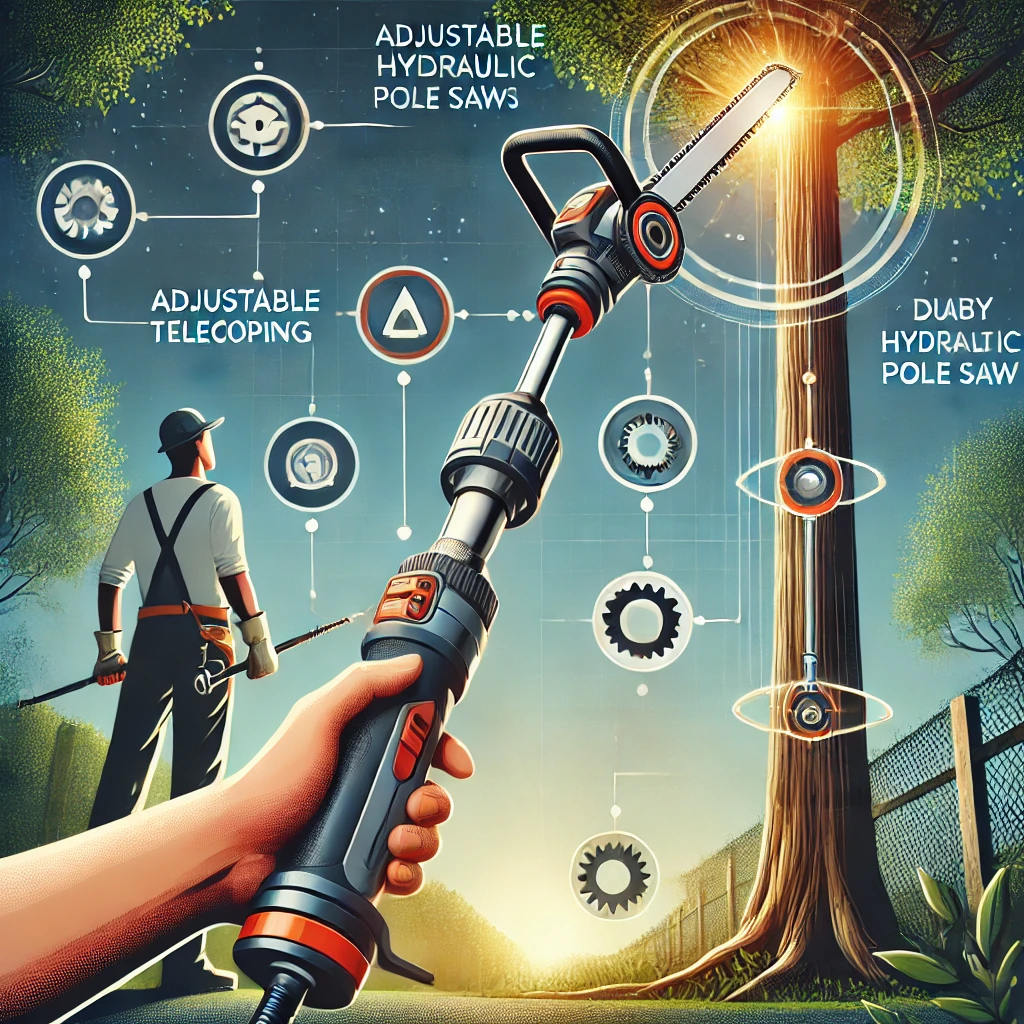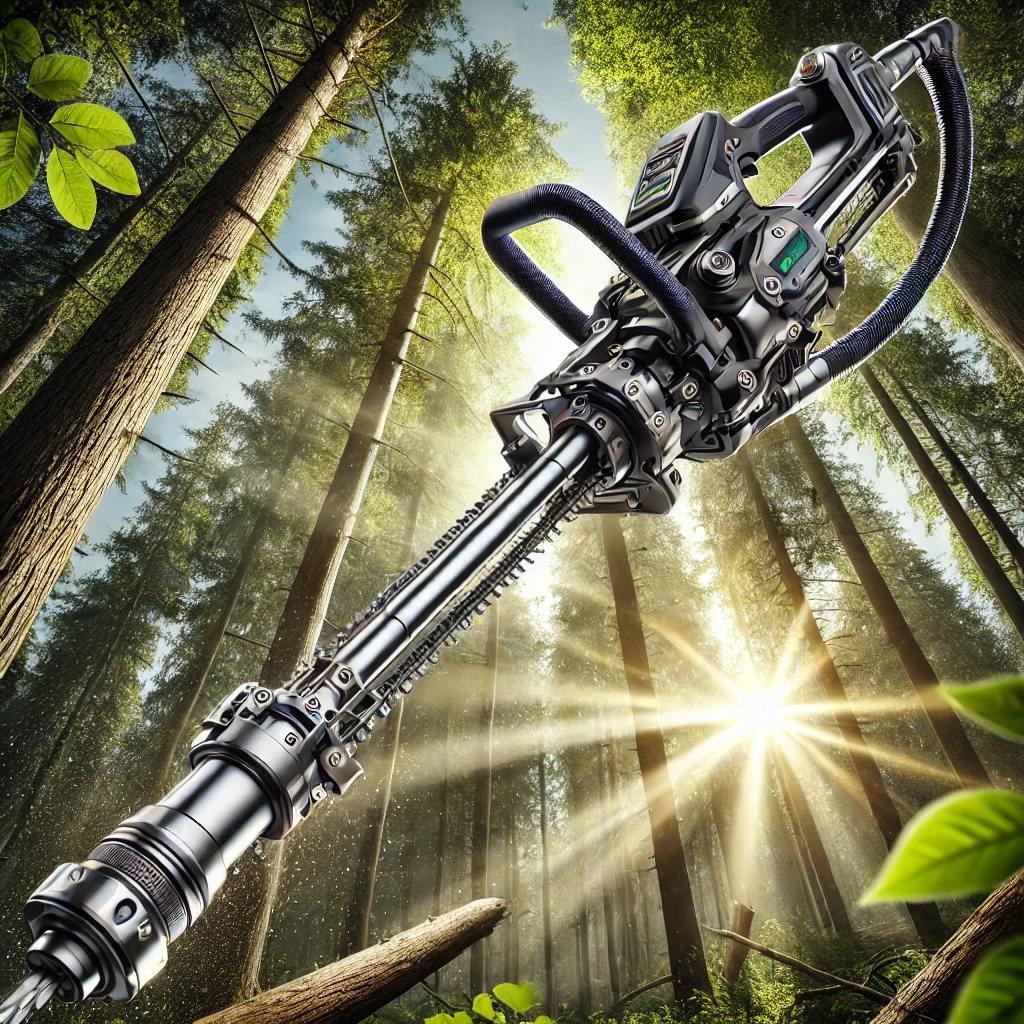If you’re tackling demanding tree-trimming tasks, investing in a hydraulic-powered pole saw can make your work more efficient. Hydraulic pole saws are a game-changer in heavy-duty pruning and forestry tasks, offering power, durability, and precision. This guide will walk you through the features, benefits, pros, cons, and frequently asked questions to help you make an informed decision.
Table of Contents
What is a Hydraulic-Powered Pole Saw?
A hydraulic-powered pole saw is a tool that uses hydraulic systems to power its cutting mechanism. These saws are typically used in professional environments, such as forestry, landscaping, and utility line maintenance, where robust performance and reliability are essential.
Pros
Cons
Features to Look for in a Hydraulic-Powered Pole Saw
- Powerful Cutting Performance
Hydraulic-Powered Pole Saw deliver high torque, making them capable of cutting through thick branches and dense wood with ease. - Adjustable Pole Length
Many models come with extendable poles, allowing you to reach heights of up to 20 feet, ideal for trimming tall trees. - Durable Construction
Built for heavy-duty tasks, these saws often feature corrosion-resistant materials, reinforced poles, and industrial-grade chains. - Lightweight Design
Despite their power, Hydraulic-Powered Pole Saw are often designed to minimize operator fatigue, with ergonomic handles and balanced weight distribution. - Compatibility with Hydraulic Systems
Ensure the saw is compatible with your existing hydraulic power source, such as a skid steer or hydraulic pump. - Safety Features
Look for features like anti-kickback chains, chain brakes, and insulated grips to enhance safety during use.
Benefits of Hydraulic-Powered Pole Saws

- Unmatched Power
hydraulic-powered pole saw outperform electric or gas-powered counterparts in terms of cutting strength, making them ideal for industrial applications. - Efficiency in Large-Scale Projects
They maintain consistent power over extended use, which is crucial for professional or large-scale pruning tasks. - Low Maintenance
With fewer moving parts than gas engines, hydraulic systems are generally more reliable and require less maintenance. - Eco-Friendly Operation
Unlike gas-powered models, hydraulic pole saws do not emit harmful fumes, making them a cleaner option for outdoor work.
How to Choose the Right Hydraulic-Powered Pole Saw
- Assess Your Needs
Consider the type of work you’ll be doing. For frequent, heavy-duty pruning, invest in a saw with a high cutting capacity and durability. - Check Compatibility
Ensure the saw is compatible with your existing hydraulic system to avoid additional costs. - Prioritize Safety
Look for safety features like chain brakes and anti-vibration systems, especially if you’re new to using hydraulic tools. - Compare Brands and Reviews
Research top brands like Stihl, Husqvarna, and Echo. Read customer reviews to gauge reliability and performance.
You may also like
Why an Adjustable Hydraulic Pole Saw is a best for tree trimming
Tree trimming and maintenance can be physically demanding and time-consuming, especially when dealing with tall trees and thick branches. Enter the adjustable hydraulic pole saw—a revolutionary tool that has transformed the way professionals and homeowners tackle these tasks. This guide delves into why an adjustable hydraulic pole saw is a game-changer, highlighting its features, benefits, pros, cons, and frequently asked questions.
What is an Adjustable Hydraulic Pole Saw?
An adjustable hydraulic pole saw is a powerful tool designed for cutting branches at various heights. Its hydraulic-powered mechanism ensures robust performance, while the adjustable pole allows users to extend or retract the saw to reach different heights efficiently. This combination makes it ideal for tasks ranging from pruning tall trees to cutting overhanging branches with precision.
Key Features of Adjustable Hydraulic Pole Saws

- Adjustable Pole Length
- The pole’s extendable design enables users to customize the reach, often spanning up to 20 feet or more.
- Hydraulic Power System
- Powered by hydraulic systems, these saws offer unmatched cutting strength and consistency.
- Precision Cutting
- Equipped with sharp, high-quality chains, these saws ensure clean cuts, reducing the risk of damaging trees.
- Ergonomic Design
- Adjustable hydraulic pole saws are designed with user comfort in mind, featuring anti-slip grips and balanced weight distribution.
- Durable Build
- Built with industrial-grade materials to withstand heavy-duty tasks and harsh environments.
- Safety Enhancements
- Includes safety features like chain brakes, anti-kickback systems, and insulated handles.
Why an Adjustable Hydraulic Pole Saw is a Game-Changer
- Versatility in Height and Reach
- With its adjustable pole, this tool eliminates the need for ladders or climbing trees, making it safer and more efficient.
- Enhanced Cutting Power
- Hydraulic power provides consistent torque, enabling it to cut through thick branches and dense wood effortlessly.
- Efficiency and Productivity
- Adjustable hydraulic pole saws allow users to work faster and more effectively, especially in professional settings.
- Reduced Physical Strain
- The adjustable pole minimizes the need for awkward positions, reducing fatigue and the risk of injury.
- Eco-Friendly Operation
- Unlike gas-powered tools, hydraulic systems produce no emissions, making them an environmentally conscious choice.
- Evaluate Your Needs
- Consider the height of the trees and the frequency of use. A longer adjustable reach may be better for taller trees.
- Check Hydraulic Compatibility
- Ensure the saw is compatible with your hydraulic power source, such as a tractor or skid steer.
- Focus on Safety Features
- Look for anti-kickback chains, chain brakes, and ergonomic handles to enhance safety.
- Compare Brands and Models
- Research top-rated brands and read reviews to find a reliable and efficient model.
- Budget Appropriately
- While the initial investment is high, the durability and efficiency of these saws often justify the cost.
FAQs
1. Can I use a hydraulic pole saw for residential purposes?
Yes, but Hydraulic-Powered Pole Saw are better suited for large-scale or professional tasks. For occasional residential use, consider a gas or electric pole saw.
2. How do I maintain a hydraulic-powered pole saw?
Regularly clean the chain, check hydraulic connections for leaks, and ensure the chain is sharpened. Follow the manufacturer’s guidelines for maintenance.
3. What is the average cost of a hydraulic pole saw?
Hydraulic pole saws typically range from $500 to $2,000, depending on features and build quality.
4. Are hydraulic pole saws environmentally friendly?
Yes, they produce no emissions during operation, making them an eco-friendly alternative to gas-powered saws.
5. How long can a hydraulic pole saw operate continuously?
The operating time depends on your hydraulic power source, but they can generally run as long as the hydraulic system provides power.
Conclusion
A hydraulic-powered pole saw is a robust tool for professionals and serious DIY enthusiasts looking to tackle challenging pruning tasks. By understanding the features, benefits, and potential drawbacks, you can select the right model to meet your needs. Focus on durability, safety, and compatibility to make the most of your investment.
Whether you’re clearing utility lines or maintaining a landscaped garden, a hydraulic pole saw can transform your tree-trimming experience. Choose wisely, and enjoy the efficiency and precision of hydraulic power!



Leave a Reply